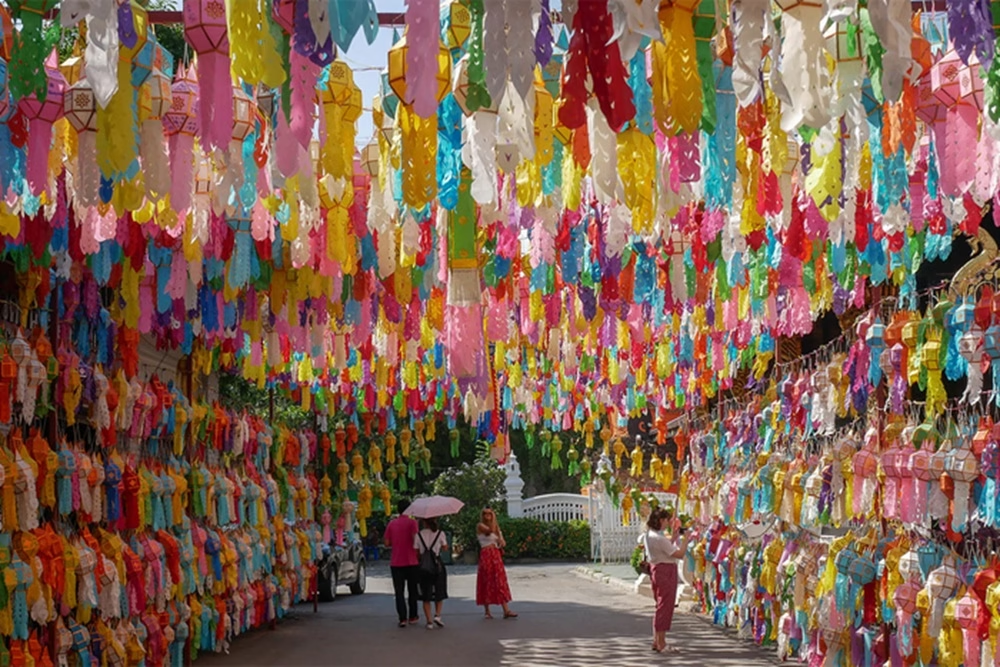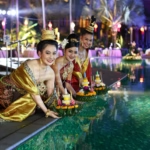Chiang Rai carries a quiet heartbeat of Chinese culture. You see it in tea hills and temple roofs. You hear it in shop chatter and festival drums. Families from Yunnan began moving here more than a century ago. A larger wave arrived after 1949.
They built homes, farms, and schools, and many settled in Santikhiri, known as Doi Mae Salong. Today, the story lives on in places like Wat Huay Pla Kang, hillside tea plantations, red lanterns, and lion dances.
This is not a replacement for Lanna heritage. It is a blend. Markets, kitchens, and festivals show both, side by side. By the end, you will have a simple route, the best stops, and what to try, so you can feel the Chinese influence in Chiang Rai.
From Yunnan to Chiang Rai: How migration shaped a Chinese Thai identity
Trade brought Yunnanese families through the northern hills long before roads. They moved along mule tracks, sold tea and cloth, and married into local communities. Small shops and inns grew at crossroads, and the accents of Yunnan settled with them.
A turning point came in 1949. Kuomintang soldiers and their families left Yunnan and sought refuge across the border. The mountains of Chiang Rai offered safety, cool air, and farm land. Over time, many gained Thai citizenship. They learned Thai, sent children to Thai schools, and used Mandarin or Yunnan dialects at home.
Santikhiri, in Doi Mae Salong, became a core base. At first, hill crops and the opium economy shaped life in the highlands. That changed with crop replacement. The community shifted to legal farming, first tea, then fruit and vegetables. Oolong became the lifeline. Families turned military discipline into careful tea work, from planting to roasting.
Walk through markets and you notice the mix. Shop signs often show Thai scripts and Chinese characters. Bakeries steam mantou buns next to Thai snacks. Children switch between Thai and Mandarin with ease. Lanna Buddhism aligns with Chinese beliefs, so you may see a family visit a Thai wat in the morning, then light incense for Guan Yin in the evening.
This blend shows up in everyday spaces. Schools teach Thai and sometimes offer Mandarin clubs. Community halls host lion dance practice before the Chinese New Year. Street food carts fry noodles beside stalls serving khao soi. The identity is both Chinese and Thai, practical and proud, shaped by home, work, and the hills.
Yunnanese routes and the 1949 Kuomintang resettlement
Conflict pushed people south, trade pulled them along old routes. The border ranges made Chiang Rai a natural refuge. Valleys offered fields, and hilltops gave watch points and cool weather for tea. The location near Myanmar and Laos added more trade links, so new shops and markets made sense. Over the decades, soldiers became farmers, and families put down roots.
Santikhiri (Doi Mae Salong): from outpost to tea town
Santikhiri began as a remote outpost. Today, it reads like a small Chinese town in the clouds. Chinese-language signs hang over tea shops. Families roast oolong in small batches. Visitors can taste, tour gardens, and buy leaves directly from growers.
If you want a deeper story before you go, read about Mae Salong’s vibrant Chinese heritage. It covers traditions, food, and how tea reshaped the hills.
Trade, language, and schools in Chinese-Thai communities
Markets speak many languages. Elders chat in Mandarin with a Yunnan lilt. Vendors switch to Thai when kids walk up. Schools teach in Thai, and many add English. Community groups run weekend classes for Chinese reading and lion dance. Young people move between both cultures with ease, and that mix feels normal, not staged.
Lanna meets Chinese: faith, family, and festivals.
You will see Thai wats alongside shrines for Guan Yin or local deities. Families burn incense for ancestors, then tie white strings for blessings at a Lanna ceremony. People join Thai and Chinese festivals without fuss. It is the rhythm of the year, lived in homes, markets, and temples.
Where to see Chinese culture in Chiang Rai today: temples, villages, and viewpoints
You can feel the Chinese influence across the province. Start near the city, then head for the hills. Keep a modest outfit for temples, carry small cash for tea and snacks, and travel early or late for soft light.
Wat Huay Pla Kang: Guan Yin statue and Chinese-style pagoda
This temple sits on a hill just outside Chiang Rai city. A giant white Guan Yin statue looks over fields and villages. A 9‑tier pagoda rises beside it, with Chinese-style carvings and calm courtyards.
Arrive at sunrise or late afternoon for the best photos and fewer crowds. Dress modestly, cover your shoulders and knees, and move quietly near people at prayer. The view from the hill is wide, and the light on the white statue is beautiful on clear days.
Santikhiri tea plantations and markets: taste Yunnan in the hills
Drive up to Doi Mae Salong for tea terraces, crisp air, and family‑run tastings. Shops offer light and roasted oolong, sometimes with free sips and a quick lesson. The market sells dried fruits, pickled greens, tofu, and handmade noodles. Many stalls cook simple Yunnan meals, like braised pork knuckle with mantou.
Buy tea at the source to support local families. Ask for brewing tips, and take a photo of the label so you can find it again. The views open after each bend, and sunrise is often clear. Late afternoon brings warm tones on the ridges.
Mae Sai border town: shrines, street food, and trading streets
Mae Sai is busy, chatty, and full of cross‑border energy. Look for small Chinese shrines near shops that sell herbs, tea, and housewares. Street corners serve noodle bowls with star anise and soy. Signs often use Thai and Chinese, and many vendors speak both.
If you visit during a festival, expect drums, lanterns, and more people than usual. Keep your valuables secure and choose well‑lit streets after dark.
City contrasts: Lanna temples beside Chinese influences
In Chiang Rai city, make a short walking loop. Visit classic Lanna wats like Wat Phra Kaew and Wat Phra Singh. Then step into nearby markets for Chinese snacks, dried tea, and bilingual signs. The contrast is gentle, not sharp. It shows how neighbours share space and rhythm.
For a sense of current visitor trends that may affect crowds and opening times, see this snapshot of the Chinese tourism decline in Chiang Rai. It helps set expectations if you are timing a trip in peak or quiet months.
Food and tea with Yunnan roots: what to eat in Chiang Rai
Food tells the story best. Yunnan dishes show up in homes, markets, and small dining rooms. Expect soy, star anise, pickled greens, tofu, and slow braises. In the north, Chinese techniques mix with Thai flavours, so you get noodles next to khao soi, and mantou alongside sticky rice.
Tea binds it all together. Santikhiri’s oolong ranges from fresh and floral to warm and roasted. Tasting is simple and friendly, and most shops love to teach. Night markets in Chiang Rai city round out the day with snacks and easy plates.
Yunnan dishes to try: simple, hearty, and aromatic
- Braised pork knuckle (kha moo): soy, cinnamon, star anise, melting texture.
- Mantou buns: soft steamed bread, great for soaking sauces.
- Hand‑pulled noodles: chewy strands with clear broth or bean paste.
- Yunnan hotpot: light broth, mushrooms, greens, thin‑sliced meats.
- Pickled mustard greens: tangy and bright, a side dish or stir‑fry.
- Tofu with black bean sauce: savoury, peppery, great with rice.
For kids, choose mild broths, plain mantou, and tofu. For spice lovers, ask for chilli oil or pepper flakes on the side.
Tea on Doi Mae Salong: oolong styles and tasting tips
Oolong here comes in two main styles. Light oolongs taste floral and sweet, best for daytime sipping. Roasted oolongs feel toasty and smooth, nice for cool evenings.
Tasting tips:
- Warm the cup with hot water first, then pour it out.
- Use short infusions, 10 to 20 seconds, and taste again as leaves open.
- Smell the empty cup, it holds the aroma.
- For gifts, ask for vacuum‑sealed bags and brewing instructions.
Chinese techniques in northern Thai cooking
Stir‑frying is everywhere, quick and hot, with garlic and soy. Noodles appear in soups and dry dishes. Tofu is common, often stir‑fried or braised. Soy sauce, black vinegar, and fermented bean pastes add depth to northern Thai favourites, including khao soi’s base and many street‑side stir‑fries. The result feels homely, fragrant, and made for sharing.
Where to eat: markets, tea houses, and village kitchens
- Santikhiri tea houses: try flight tastings, light snacks, and buy small‑batch oolong.
- Village kitchens: family places with braises, noodles, and pickled greens, open late morning to early evening.
- Chiang Rai Night Bazaar: easy plates, tofu stir‑fries, noodles, and Chinese snacks, from late afternoon.
Ordering tips:
- Point to dishes or photos, then say “mai phet” if you want less spice.
- Sharing feels normal, take small portions, and pass the plate.
- Carry small notes and coins for tea and snacks.
Festivals and best times to visit for Chinese traditions
Festivals bring the cultural blend to life. Plan for crowds and bright colours in January and February. Expect softer family gatherings in the mid‑autumn period. Lanna events in November and April add lanterns and water, so you can see both calendars in action.
Chinese New Year in Chiang Rai and Santikhiri
Chinese New Year fills Chiang Rai city with parades, lion dances, red lanterns, and temple visits. The Great Chinese New Year 2025 at Central Chiang Rai runs from 21 January to 3 February, with shows, food stalls, and workshops. Santikhiri hosts lion dances, tea events, and family meals, with music rolling across the hills.
Arrive early to find space along parade routes. Drums can be loud, so bring ear protection for young children. Take breaks in quiet lanes, then return for the evening lights.
Mid‑Autumn Festival: mooncakes, tea, and lanterns
Mid‑Autumn usually lands in September or October. Families share mooncakes and pour tea at home, in shops, or on hill viewpoints. In Santikhiri, sunset is a lovely time. The light fades, lanterns glow, and the tea warms cold fingers.
How Chinese and Lanna calendars blend in real life
You might see a family light lanterns for Mid‑Autumn one month, then join Yi Peng and Loy Krathong in November. In April, the same family will splash water for Songkran, then save red envelopes for the next New Year. It is easy and friendly, and no one has to choose one over the other.
Respectful travel tips for cultural events
- Dress modestly at temples, cover shoulders and knees.
- Keep quiet during prayers, step aside for rituals.
- Ask before taking photos of people.
- Carry small cash for offerings and snacks.
- Buy local tea or treats to support hosts.
- Take your rubbish with you, keep hills and streets clean.
- Book rooms early for festival dates, and plan rides in advance.
Conclusion
Chinese culture in Chiang Rai is not a show; it is a fabric woven through people, places, food, and festivals. A simple route links city temples, Wat Huay Pla Kang, the tea hills of Santikhiri, and a night market meal. Every stop tells a story, and every cup of oolong holds a piece of the past.
Learn a greeting in Thai, “sawasdee krap/ka,” and a word in Mandarin, “ni hao.” Buy tea straight from growers and ask about their farm. Travel with care, smile often, and enjoy this living heritage. Pick a festival date, book a night in the hills, and taste the stories in every cup.


















